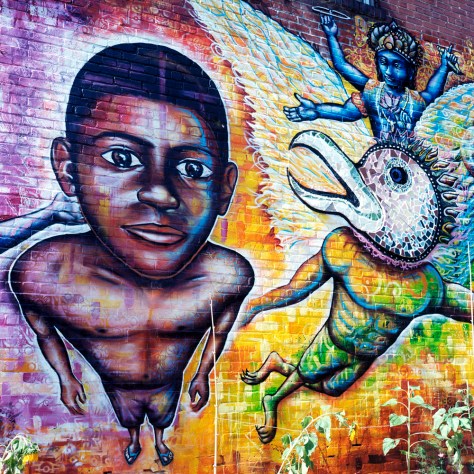Here are two images of the same scene, one in color, one in black and white. I’m sharing them together to demonstrate how the change from one to the other totally changes the way we feel about the image.
First, the black and white:

Notice the visual emphasis – how the tones draw your eye to specific parts of the scene. What do you find yourself looking at, and relating to? What compels you? What emotions does this evoke?
Now the color:

This has a very different balance. The colors change the emotional timbre of the image, as well as the focus point for the viewer, even though both photos were taken from essentially the same vantage point. I think it’s fair to say that in the black and white version, your eye and attention keep coming back to the boy. The image has a more stark, somber feel to it whereas the color image is much more lively, and balanced – it’s easier to view both sides equally. To be entirely fair, some of the impact of the black and white version is due to the way in which it was exposed and processed. This version is fairly high contrast, which makes the dark areas very rich and the whites very pure white. Were it done differently, there would be a greater balance between the boy and the garuda in terms of tones, and it would have a different resonance.
This is actually very interesting. And you’re right; in the B/W version you do look at the boy, whereas in the color version the bright colors of the fire/light around the bird demands your attention. This is a really cool post, it makes you think more about which to use in a shot.
Fascinating contrast between the two images. I like the way that you evenhandedly pointed out the advantages of the two different approaches. Usually, the question is posed in a way in which we are asked to choose which one is “better.” Your comments on processing are interesting too. Consciously or unconsciously, a photographer makes a lot of choices to draw the viewers’ attention to what he would like them to see. Can photography ever really “just” represent reality?
The notion that photography represents some “essential truth” about its subject is perhaps the single biggest lie in photography. EVERYTHING about it is subjective, from the moment we pick up one camera vs another on our way out the door in the morning to the moment the final print is hanging on the wall. This would look very different if I photographed it using my Canon 5D, and different yet again if I used my #2 Kodak Brownie Autographic. They obviously look different in black and white vs. color, and they would look different again if I chose to photograph one with a very large aperture vs. a small one (although that would, in this case, be a bad choice, as it would either not show to the untrained eye when photographing the mural square on because it’s a mural, or it would render a narrow slice of the mural sharp and leave the rest unintelligible, which would be stupid, as the mural is the subject).
I purposely left it up to the viewer to draw their own judgment about the two images. Each has their own resonance, and you will respond differently than the next person. I don’t judge either one being “better” myself – I like both equally, because they have different strengths.